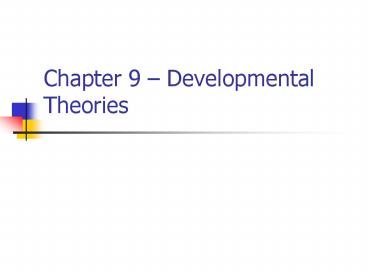Chapter 9 Developmental Theories - PowerPoint PPT Presentation
1 / 31
Title:
Chapter 9 Developmental Theories
Description:
1) Inadequate socialization leads to weak social controls ... 4) Bonding variables and Learning variables lead to delinquent behavior ... – PowerPoint PPT presentation
Number of Views:252
Avg rating:3.0/5.0
Title: Chapter 9 Developmental Theories
1
Chapter 9 Developmental Theories
2
Developmental Theories
- Purpose of developmental theories is to provide a
more powerful explanation of crime - Most single-factor theories focus on the onset of
crime but poorly explain escalation and desistance
3
Developmental Theories
- Questions asked
- 1) Why do some offenders increase their criminal
activities, while others decrease? - 2) Why do some criminals reduce criminal activity
and then resume it again?
4
Developmental Theories
- Three types of developmental / integrated
theories - 1) Multi-factor theories
- Combine influences of structural, socialization,
conflict, choice, and trait theories
5
Developmental Theories
- 2) Latent trait theories
- Assume disposition to commit crime is stable
- Personal attribute that controls inclination to
commit crime - May be present at birth or early in life
6
Developmental Theories
- Examples of latent traits
- Low intelligence
- Genetic abnormalities
- Impulsive personality
- Etc.
7
Developmental Theories
- Because latent traits are stable, fluctuations in
offending over time reflect changes in criminal
opportunities - Based on rational choice theory
8
Developmental Theories
- 3) Life-course theories
- Assumes propensity to commit crime is not stable
and changes over time - Crime is a developmental process
9
Developmental Theories
- Recognize that as people mature, the factors that
influence their behavior change - Family influences, then peer influences, then
vocational and marital influences - Influence of changing interpersonal and
structural factors encourages or discourages crime
10
Multi-Factor Theories
- Will cover the following multi-factor theories
- 1) Elliots Integrated Theory
- 2) Colvin and Pauly Integrated Structural
Marxist Theory - 3) Hagan Power-Control Theory
11
Elliots Integrated Theory
- Explanatory model for delinquency and drug use
- Integrated strain, social learning, and control
theories
12
Elliots Integrated Theory
- Premises
- 1) Inadequate socialization leads to weak social
controls - 2) Social disorganization leads to strain and
weak social controls - 3) Strain also leads to weak social controls
13
Elliots Integrated Theory
- 4) Weak social controls and strain lead to
delinquent associations and weak conventional
values which lead to delinquency
14
Colvin and Pauly Integrated Structural Marxist
Theory
- Premises
- 1) Crime is due to socialization within the
family - 2) However, family relations are controlled by
workforce participation
15
Colvin and Pauly Integrated Structural Marxist
Theory
- 3) Negative experiences in workplace (e.g., no
power, conflict with supervisors) create strain
and alienation within family setting - 4) Negative experience in workplace leads to
inconsistent and overly punitive discipline at
home
16
Colvin and Pauly Integrated Structural Marxist
Theory
- 5) Inconsistent and overly punitive discipline at
home leads to alienation among youth - 6) Feelings of alienation from parents reinforced
by association with groups of similar alienated
peers (subculture formation) leads to crime
17
Colvin and Pauly Integrated Structural Marxist
Theory
- If want to prevent delinquency, need power and
control over root causes of delinquency - Need power and control over means of production
18
Hagan Power-Control Theory
- Discussed in book under Radical Feminist Theory
in Chapter 9 - Combined Marxist theory with control theory
19
Hagan Power-Control Theory
- Premises
- 1) Crime rates function of 2 factors
- Class position (power)
- Family functions (control)
- 2) Within the family, parents reproduce the power
relations they hold within the workplace
20
Hagan Power-Control Theory
- A position of dominance at work is equated with
control in the household - 3) Paternalistic/Patriarchal families
- Father is primary worker outside of household
- Boys are more likely to deviate due to freedom
- Girls less risk-taking behavior because mother
controls their behavior
21
Hagan Power-Control Theory
- 4) Egalitarian families and female headed
households - In egalitarian families, spouses hold similar
positions of power at home and workplace - Girls and boys deviate equally in these households
22
Hagan Power-Control Theory
- Implies that middle class youth of both sexes
will have higher crime rates than their lower
class counterparts unless female-headed in lower
class
23
Latent Trait Theories
- Gottfredson and Hirschi Self-Control Theory
- Sometimes called General Theory of Crime
- Integrates concepts of social control with
biosocial, psychological, routine activities, and
rational choice theories
24
Gottfredson and Hirschi Self-Control Theory
- Premises
- 1) Crime rates fluctuate according to criminal
opportunities (rational choice and routine
activities) - Individual differences are stable over the life
course and so is propensity to commit crime
only opportunity that changes
25
Gottfredson and Hirschi Self-Control Theory
- 2) Individual differences in tendency to commit
crime can be found in persons level of
self-control - Latent trait is low self-control
- 3) Low self-control leads to impulsive personality
26
Gottfredson and Hirschi Self-Control Theory
- Can explain gender differences in crime
- Males have lower self-control than females
27
Life Course Theories
- Assume that multiple social, personal, and
economic factors can influence criminality and
that these factors change over time, so too, does
criminal involvement
28
Thornberry Interactional Theory
- Integrated social disorganization, social
control, and social learning - Premises
- 1) Social class, race, gender, and neighborhood
characteristics influence bonding variables and
learning variables
29
Thornberry Interactional Theory
- 2) Bonding variables include
- A) attachment to parents
- B) commitment to school
- C) belief in conventional values
30
Thornberry Interactional Theory
- 3) Learning variables include
- A) association with delinquent peers
- B) formation of delinquent values
31
Thornberry Interactional Theory
- 4) Bonding variables and Learning variables lead
to delinquent behavior - 5) Delinquent behavior also leads to reduction in
bonding variables and learning variables - Why it is called interactional theory































